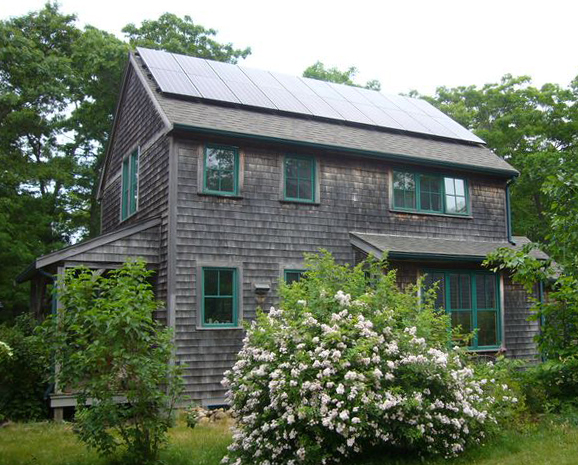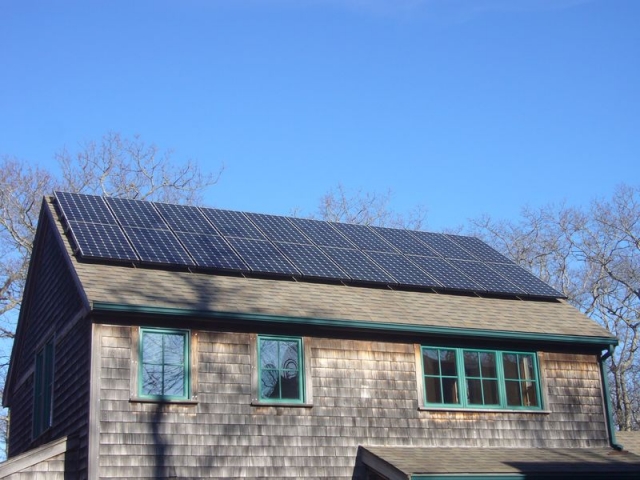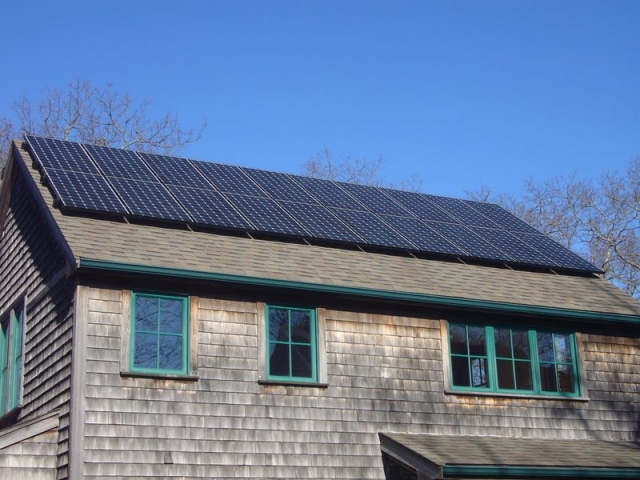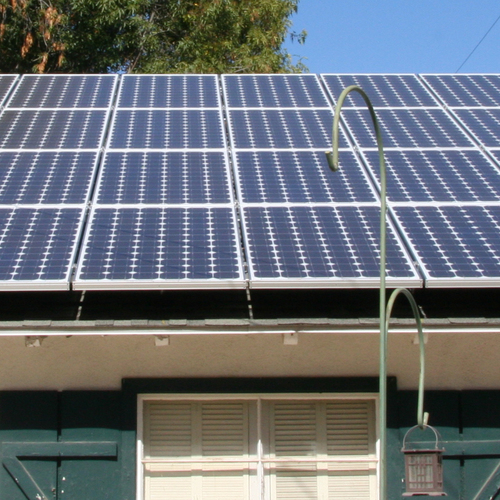Image Credit: Marc Rosenbaum
[Editor’s note: What follows is a compilation of blog entries by Marc Rosenbaum describing the performance of the photovoltaic system installed on the roof of his Massachusetts house.]
May 2011: The price is right
We intend to install a 4.76 kW Sunpower solar electric array sometime in the next month. The combination of the falling prices for photovoltaic (PV) modules, along with the Massachusetts Solar Renewable Energy Credits (SREC) program, the Massachusetts Clean Energy Center rebates that are still available (though diminished), and the federal 30% tax credit for renewables, makes the installation of PVs a better investment than any other available to people like us, who don’t have supercomputers to manipulate the stock market.
The PV array here will have a bit of shading, and I don’t know exactly how many kWh it will make annually. Unshaded, it would be 5,700 kWh or more in a typical year. This means we could likely be net zero on an annual basis, even perhaps without the solar domestic hot water system.
I think we’ll net at least 5,000 kWh per year from the system. Looking at our projected usage more closely by month, I think it is possible that if we primarily use the wood stove to heat for the coldest and cloudiest months — say, December through February — we might be able to hit net zero on a month-by-month basis. It’s dicey in December, when the shading on the solar systems will be greatest, but that makes it a worthy target.
Weekly Newsletter
Get building science and energy efficiency advice, plus special offers, in your inbox.
We will shoot for monthly net zero electrical energy — that is, to use no more electricity than the PV system generates on a monthly basis — and supplement with no more than a cord of firewood. Will we get to our goal? Don’t change that dial …
Early June 2011: Meter spinning backwards!
Today my colleagues Phil Forest and Jonny Lange, the ace PV crew at South Mountain Company, put the finishing touches on a 4.76-kW solar electric system at our house. With the help of Sean Welch, my go-to electrician for all the work here, they had it fired up shortly after lunch and by the end of the day the system had produced its first 11 kWh.
I installed my first solar electric system — a 1.06-kW array — in 1999, when New Hampshire first mandated net metering. We’ve come a long way in system and component quality and reliability and efficiency, and costs have dropped dramatically over that time. And of course, the cost of electricity has risen significantly. My new system is almost 5 times as large as the one I had back in New Hampshire.
The system consists of 20 Sunpower 238-watt panels and a Sunpower 5,000-watt inverter that is manufactured by SMA. The premium aspects of Sunpower products (they offer the highest efficiency panels, for example, and an excellent warranty) are a good fit for South Mountain Company. We have been seeing annual kWh outputs per watt of panel that exceed the modeling we do. Of course, this could be due to variations in weather as easily as product quality.
The system is grid-intertied, which means that it only runs when the grid is up. (Uunfortunately, it’s not an emergency power system.) When energy is being produced, it is first used at the house to satisfy our energy needs. Any excess is exported to the utility grid and turns the electrical meter backwards.
A concept called net metering, which was legislated into being in the late 1990s, allows this direct back-feeding of the grid and allows the exported power to be traded (one for one) for imported power. In the bad old days, the utility would charge retail for power in and pay wholesale for power delivered to the grid.
It’s quite likely that our excess energy won’t ever hit the grid, because there are 15 other houses here plus the Common House, so my guess is that the excess will be used here in out cohousing neighborhood.
A special meter to monitor the system
My electric utility, NSTAR, generously swapped my meter for a commercial demand meter. This is a bit of special treatment (thanks!) that will allow me to know more than the net energy in or out each month. This meter shows separately the net, as well as the energy supplied by the grid and the energy received by the grid from the PVs.
Say that in a month we use 350 kWh and the PVs generate 400 kWh. A normal meter will read 50 kWh lower at the end of the month that it did at the beginning. Because the inverter has a record of the energy generated, a PV system owner can still determine how much energy they used during that month. My new meter takes this a step further and will tell me how much of the energy generated was used on site and how much was exported.
Neighborhood controversy and shading issues
It feels like it’s been a long road to get this system in place. In a Cohousing monthly meeting a few months ago at which we discussed solar access and the cutting of trees, one of my neighbors read an impassioned statement that included assertions that solar was not economically feasible and no one besides me wanted solar anyway. I was pretty shocked, not because of the statement (in the interests of diversity we have a token Tea Party supporter and this was his shot across the bow of the ship of liberal fools), but because no one spoke up to counter a passel of distortions.
Our house has significant shading from trees on my neighbor’s land to the south, and even though we’d just bought the house, I was ready to put it back up for sale if those trees were staying. When the cohousing was being planned, there were design guidelines put in place, one of which was to provide at least 300 square feet of unobstructed south-facing roof on each house for future solar collection.
Unfortunately, they decided trees could always be cut later, so they actually did an oustanding job of preserving trees quite close to the houses. People here in Coho don’t seem to crave natural light inside their homes nearly as much as Jill and I do, so the houses are generally in a very wooded setting, and very shaded.
PVs are wired together in strings of several panels, so when one is shaded the output of all the panels in that string is degraded. (One technical approach that can minimize this issue is to use microinverters.)
I was quite fortunate that my southerly neighbor came around and was very gracious about allowing some tree cutting. In the end, I didn’t ask for 100% solar access, and only took the largest and closest tree. She picked a lovely dogwood to replace the big white oak we cut, and I did get some firewood for my pains 🙂
The system we installed, completely unshaded, would make perhaps 5,700 kWh per year in a typical year. (The eight houses that South Mountain Company designed and built at Eliakim’s Way have 5.04-kW arrays and averaged over 6,700 kWh this past year.) I’m expecting at least 5,000 kWh — we’ll see!
Rebates, tax credits, and SRECs
This is an excellent time to install solar electricity in Massachusetts. The Massachusetts Clean Energy Center is still offering a rebate on PVs; the rebate is declining every year as the costs drop.
There is also the 30% Federal tax credit and a $1,000 Massachusetts state tax credit. (Information on all this stuff, and more is at the DSIRE website.) These all bring the system cost down from a cost of perhaps $7 per watt to slightly over $4 per watt.
In Massachusetts, there’s a sales tax exemption if this is a primary home, too. On Martha’s Vineyard, if a system makes 1.25 kWh/watt of rated output annually, that is worth about $0.23. So the simple payback is eighteen years.
But electricity has inflated far above the general rate of inflation, and the actual payback will be significantly quicker. The average person can’t get a guaranteed return on their investment anywhere near as good as solar electricity, and offset energy usage is income that isn’t taxed.
The current financial frosting on the cake, however, are what are called Solar Renewable Energy Credits, or SRECs. The state requires utilities to get a percentage of their power mix from renewables, and some of that specifically from solar, and they can buy SRECs to satisfy that requirement from solar power producers such as moi.
In practice, most SRECs are bought from individual producers by aggregators who sell larger blocks at auction. The goal is 400 MW of solar generating capacity in Massachusetts. One megawatt-hour (MWh) is one SREC. The auction prices have been as high as $550/MWh, and the floor price is $285/MWh. If our system makes 5 MWH/year, we could be receiving an additional $1,500 – $2,500 per year!
Even if that program falls flat on its face, though, it’s a great feeling watching that meter spin and rack up the solar energy.
Late June 2011: Even on cloudy days, we’re producing power
After two weeks, the PV system has generated 268 kWh. Half of the days have been sunny, and on those days the system makes 25 to 30 kWh. What’s been surprising to me is the days where the sun doesn’t appear, and the system makes 4 to 6 kWh.
I have that commercial meter I mentioned in the first post on the system. Thus far, of the 268 kWh, 41 kWh have been used at the house and 227 kWh have been sent to the grid. I would guess that this all gets used in the cohousing, but I don’t have any way of knowing that.
We’ve used about 112 kWh during these two weeks, so we’ve imported 81 kWh even though the meter reads 134 kWh lower than when the system came on line. This is a good reminder that we need the grid — it’s replacing an on-site battery, by allowing us to send out the surplus and import when the sun doesn’t shine.
August 2011: Using the electric grid as our “battery”
The commercial meter from NSTAR gives me more information than a standard residential meter, and the most interesting information is the separate tally of how much energy the grid has supplied to our house, and how much energy our PV system has sent to the grid. Here’s data for the past two weeks:
- PV generation, 270 kWh (19.3 kWh/day)
- PV sent to grid, 230 kWh (16.4 kWh/day)
- PV used on site, 40 kWh (2.9 kWh/day)
- Grid delivered to the house, 59 kWh (4.2 kWh/day)
- Total used on site, 99 kWh (7.1 kWh/day – higher than usual because we have a 60W light on 24/7 for our new chicks!)
Grid-tied systems don’t have on-site storage, so once the system stops producing, energy used comes from the grid. The grid is the battery. For utilities that are called on to produce their peak power output in the summer, this way of operating is helpful. The PVs produce during the peak demand time period, typically afternoon, lowering the utility peak, and the house’s need for power at night helps balance the utility load.
It will be interesting when winter comes and the heat pump load is added to our base load, while the PV system output drops due to lower solar availability. We’ll be net importers unless we use the wood stove instead of the heat pump, and we’ll be whittling down our net energy credit, which stands at over 800 kWh now.
December 2011: A tree shades our PV array
When I put the solar electric array in, I knew that there would be some shading from an oak on my neighbor’s property that I could have had removed, but didn’t want to spend the additional money. Now that we’re in winter solstice season, and because today is clear and sunny, I took some shading photos and looked at the output of the array. Here’s a shot at about 10 a.m., when the tree is beginning to appear on the array:
At 11:50 am, 18 minutes later, the array is unshaded and the output jumps to 3,900 watts, which is 82% of the rated output, and typical of peak output.
I have some data I took at 10:30 a.m. on Dec. 11th, and with the tree smack dab in the middle of the array, the output was 1 kW lower than what it was at 11:50 a.m., 80 minutes later. So I conclude that during the roughly 1 1/2 hours that the tree crosses the array, I’m losing about 1 kW, or about 25% of the peak output.
My house faces about 11 degrees east of south, so 11:00 a.m. this time of year is when the sun is perpendicular to the array. From here on out the output will drop. At 12:30 p.m., it’s down to 3,650 watts. At some point, the smaller trees to the west will start to shade the array and output will drop off quickly.
May 2012: One year of performance data
When the commercial NSTAR meter was installed, it read 000,000 kWh. On a meter without a grid-tied power source, this number would only go up. Here, it can go either way, depending on whether we use more than the PV system produces, or not.
After one year, the meter reads 97,409. Either we’ve used a hell of a lot of energy, or we’ve sent more energy to the grid than was consumed on site. I think it’s the latter. The PV system didn’t go operational until the afternoon of June 9th, so this net export of 2,591 kWh includes about two weeks where the energy flow was only incoming.
The stats:
- 3,813 kWh consumed on site
- 2,752 kWh imported
- 5,343 kWh generated and exported
- 6,403 kWh generated
- 1,060 kWh generated and consumed on site.
This year’s usage can be compared with program benchmarks such as Passivhaus (PH) and Thousand Home Challenge. My allotment of site energy usage according to the Thousand Home Challenge is 5,375 kWh, so we used 71% of our allotment. Of course, it has been a very warm winter, so it’s not quite as rosy as that looks. But we’ve met the Thousand Home Challenge quite handily.
The most meaningful Passivhaus criterion is Primary Energy (PE). Primary energy is the energy consumed to get the energy to the site as well as the site energy. For electrical grids it’s about three times higher than the site energy. (The Passivhaus software used 2.7 as the primary energy factor in Germany; various sources say it’s over 3 here in the U.S.)
The Passivhaus PE criterion is in kWh per square meter of Treated Floor Area (TFA, following the German convention for calculating usable floor area). This house would have about 150 square meters of TFA. The criterion is 120 kWh/square meter of TFA, so the limit here would be 18,000 kWh/year of PE, or, using a PE factor of 3, 6,000 kWh of site energy usage. We managed to be comfortably below that limit this past year.
I have proposed an amendment to the Passivhaus standard for New England. I propose that the PE limit be set according according to the number of bedrooms rather than according to floor area. How did we do according to the amendment? A three-bedroom house is permitted 13,600 kWh/year, a good bit lower than permitted under the standard as is. With a PE factor of 3, the site energy limit would be 4,533 kWh/year. We squeaked under with 3,813 kWh this past year, but a really cold year might yield a different result!
June 2012: We produced more PV power than predicted
Phil Forest flipped our 4.76-kW Sunpower PV system on during the afternoon of June 9th, 2011. At the end of the day June 8th, 2012, the system had produced 6,694 kWh. On the following day, it made 22.5 kWh, so take half of that for a full year’s worth of production — afternoon to afternoon — and the total is 6,705 kWh.
I’m really pleased and not a little surprised at this total. It’s significantly over what we predicted. The system has some winter shading, too. Nonetheless, the yield was 1.41 kWh/W/year, and during the time when I had a small (1.06 kW) system at my New Hampshire home in the late 1990s/early 2000s, that system never made over 1 kWh/W/year. New Hampshire likely has a cloudier climate, and I know that this past year has been sunny (Eliakim’s Way PV production is up 6% over the first year), but some of this has to also be technology improvements.
Sunpower claims their technology is more productive in low light conditions and high temperature conditions than their competitors, and just maybe they’re right!
July 2012: We met the Thousand Home Challenge
At the end of June we had one full year of PV system operation and usage monitoring. (See the bar graph reproduced below as Image #2.)
From July 1, 2011 through June 30, 2012, we used 3,755 kWh, which would have cost about $700. This is below the Thousand Home Challenge target and likely meets the Passivhaus primary energy limit as well.
During that period the solar electric system produced 6,779 kWh, meaning that we had a net export of 3,024 kWh — handily achieving zero annual net energy. The surplus could be used to run an electric car over 10,000 miles.
It’s important to note that this was an uncommonly warm winter, and I’d expect to use 600-700 kWh more in an average year. It’s also important to note that we are a household of two — add a couple of teens and the energy balance would be different — yet I believe we could still be net-zero and meet the Thousand Home Challenge under those circumstances. With the balmy winter, we were actually net-zero every month except December and January.
Was it a good investment?
We spent about $26,000 after subsidies to get here. Some of this work was subcontracted, and some I did myself. I got some good deals, too. I think another person might have spent $40,000 to have the same work performed.
The energy bill of this house when we got it would be in the neighborhood of $3,300 annually, so the simple payback of this effort seems well within the range of reasonable, and we got a more comfortable house with better air quality.
August 2012: A production milestone
Our PV system just passed 8,000 kWh generated! And we have a surplus credit of over 3,700 kWh, which we can allocate to another meter.
Marc Rosenbaum is director of engineering at South Mountain Company on the island of Martha’s Vineyard in Massachusetts. He writes a blog called Thriving on Low Carbon.


















8 Comments
Electricity pricing is outpacing the general inflation, really?
Over the long term (say, the life of a PV array) there's very little to support the oft-stated notion (that has become a truism in some quarter) that electricity prices have outpaced the general inflation. While that can be true in certain locations or for shorter periods, but nationally the price has pretty much tracked (or even undershot) the general inflation rate over the past three decades.
http://metricmash.com/3431
Presuming a faster payback period due to electricity price inflation isn't prudent, but clearly once it's up you're protected from potential inflation.
But the price of PV has fallen in a roughly logarithmic decay over the same three decades, bringing the lifecycle cost per kwh to retail-grid-parity or better in many higher priced electricity markets.
http://blogs.scientificamerican.com/media/inline/blog/Image/naam-solar-moore_s-law-1.jpg
Should the "balance of system" hardware and "soft costs" (design, permitting & inspection) in the US fall to the point that small scale PV reaches the current German average of ~$2.25/peak-watt, installed (before subsidy!) it becomes a near no-brainer investment in higher priced electricity markets.
http://www.greentechmedia.com/articles/read/Tackling-Solar-Soft-Costs-from-Every-Angle/
Reply to Dana
Dana, your price graph plots gas & electricity together; I'm not sure that's the right set of numbers for PV comparison, is it? Here's just Electricity:
http://metricmash.com/3432
And maybe it'd be better to look at rates since solar has really become viable; here's 2000 onward:
http://metricmash.com/3435
Looks like anyone who has installed PV since 2000 is indeed beating inflation so far.
Electricity cost
This year in my AO electricity unit cost has been falling, presumably owing to persistently low natural gas prices and the ever-increasing portion of grid power derived from NG, mostly at the expense of retiring dirty coal plants.
So far, most of my clients consider electricity cost cuts to be short lived, but if the phenomenon continues, interest in energy conservation will wane, just as an extended interval of $2 gas attracts hordes of SUVs to our roads.
Reply to Eric
Thanks for catching my missed-click on the electricity/gas graph!
But it's still important to look at longer than a decade trend when looking the lifecycle kwh costs of a PV array or any other power generator anticipated to last 30-50 years. A 25 or 30 year trend would be the shortest relevant period to consider, and over the past 30 years the cost of electricity has undershot the general inflation slightly, despite leading over the ten year trend.
Historically low pricing on natural gas and displacement of 30% efficiency thermal coal by 50% combined cycle natural gas generators, as well as the growth in midwestern wind power is putting a long term downward pressure on electricity pricing despite the near term up-trend driven by capitalization costs of those new sources. The lifecycle cost of small scale PV installed between 2000-2010 is well above retail grid parity (at the un-subsidized cost) in all but the most expensive electricity markets in the US, so to make any sense the meaning of "anyone who has installed PV since 2000 is indeed beating inflation so far " has to be parsed pretty narrowly to be true. Over the lifecycle of the array at the year 2000 PV pricing it might break even, but only if the trend over the next 30-40 year trend matches that of steepest 10 years of the last 50, which isn't very likely.
At the sub-$5/watt PV (before subsidy!) pricing that's showing up in MA this year it does much better, but it's still a decades long term investment made more viable for short-termers like homeowners only with substantial subsidy (like the SREC markets, tax incentives, and direct grants available to Marc.) At the $2.25/watt Germany 2012 average it's a decent investment.
At Marc's unsubidized cost of $7/watt it's tough to make the argument on purely financial grounds, even at Martha's Vineyard retail power costs, but at the post-subsidy $4/watt it can, but it's still a long term investment. The local cost of power in his case is going to be moderated/capped in the longer term by the Cape Wind project, which will cut the peak-power pricing, even though it's more expensive than the current base-load power. The trend over the next 20 years (the period he is citing) won't likely match the uptick since 2000, and in MA retail electricity prices peaked in 2008, and have fallen substantially since, primarily due to low natural gas pricing. If the proposed gas pipeline from the Marcellus & Utica shale formations gets built there's reason to believe it will make even further downward pressure on electricity price inflation, as do state & federal efficiency programs. The falling cost of newer PV will also make a (relatively small) mark on reining in price inflation, since (like wind power) the marginal cost per kwh is near-zero once it's up, and the capitalization costs have crashed even as subsidies have been bolstered, leading to local/regional boom in PV installation.
Needless to say, any predictions of future energy costs has huge 1-sigma error bars, but the truism popularized more than 30 years ago that electricity (and other energy) pricing outpaces average inflation isn't supported by the actual history. The price of both wind and solar electricity are continuing to fall logarithmically, and are currently approximately at fossil-grid parity. In 10 years fossil power might be more expensive (or not- the shale gas biz is still young and already overflowing), but wind & PV will be even cheaper than they are today, and those resources are still pretty far from being saturated. My crystal ball isn't showing continued inflation on Marc's power pricing at the most-recent-decade trend line, but clearly YMMV.
Reply to Dana
Dana, fair enough about my beating inflation comment - It would be more accurate to say that on average, anyone who installed PV since 2000 has seen electricity prices outpace inflation since then. You're right that the future is unwritten, though. :)
How good is the investment?
My response is, people do things that make them feel good, and the larger the expenditure the more likely it is made on emotional rather than analytical grounds. Why is the PV decision so fraught with the ROI discussion, yet the $90K kitchen remodel gets no scrutiny?
In any case, given the actual net cost, my simple payback looks to be about twelve years (system is making more than I thought). That's a better ROI than a small middle class investor is going to get somewhere else, right? And it's more reliable than the stock market.
Marc, don't get me wrong,
The ROI discussion here originated from a doubtful assertion about electricity price inflation relative to the average inflation made in your blog post. I understand completely that ROI was not the motivating factor for going there, but if you're going to make statements about the economics, I'm totally comfortable with examining those, eh? ;-)
And I'm not suggesting that it's PV a bad investment- quite the contrary (particularly at the current MA subsidy and SREC market), or that ROI & NPV are or should be a primary driver. I'm only questioning the truism that electricity price inflation outpaces the average inflation because it's demonstrably false over the relevant time periods (at least for most of the US.) For most of us, the inflation-adjusted cost of electricity has been slowly falling since before Three Mile Island or the WPPS bond failure, (and long before buck-a-watt PV panels!)
I don't have access to recent electricity price history on Martha's Vineyard, but the recent trend in much of the rest of MA has been sharply DE-flationary since 2008, not keeping pace with the general inflation at all, but moving the other direction(!). Like most of the US, electricity pricing in MA over the past 30 years electricity pricing trended below the average inflation, confounding the projections of those who claimed acid rain remediation would be too expensive and drive the cost of power through an ozone hole in the sky.
And I'm glad that you (and others) are seeing a better-than-Wall Street returns- if I had more favorable shading factors I would have jumped in 5 years ago at an even less favorable net present value. At a $2.25/watt price point I'd be tempted to open the discussion with my neighbors about lowering their 70' spruce trees though, even sans tax subsidy, grants, or SRECs, but hust because it would make me feel good.
I'm VERY bullish on the both the present and the future of small scale PV. This year's price point in Germany isn't the bottom, even though it's almost half the cost of the same systems here in the US. Even though there's a glut of keeping panel prices low, panels aren't even half the installed cost, and cheaper PV processes are still rolling out every year. (Thin-mono-crystalline silicon methods going to commercial scale in the next year or so are gearing up to crush any of the weaker players in that market.) Getting the soft-costs down to German levels is bound to happen, and the balance-of-system costs will continue to fall- as the US rollout continues apace. The cheap-PV party is just getting started!
Which parts were DIY?
Marc, would you mind telling me a little bit about the parts of the installation that you did yourself? I know that solar systems have to be installed by qualified installers to be eligible for rebates. We are planning on installing a 5 kW system here in NYC and would like to keep the costs down. Any advice would be great.
Eddy
Log in or create an account to post a comment.
Sign up Log in